Yamaha VINO 125 Manual
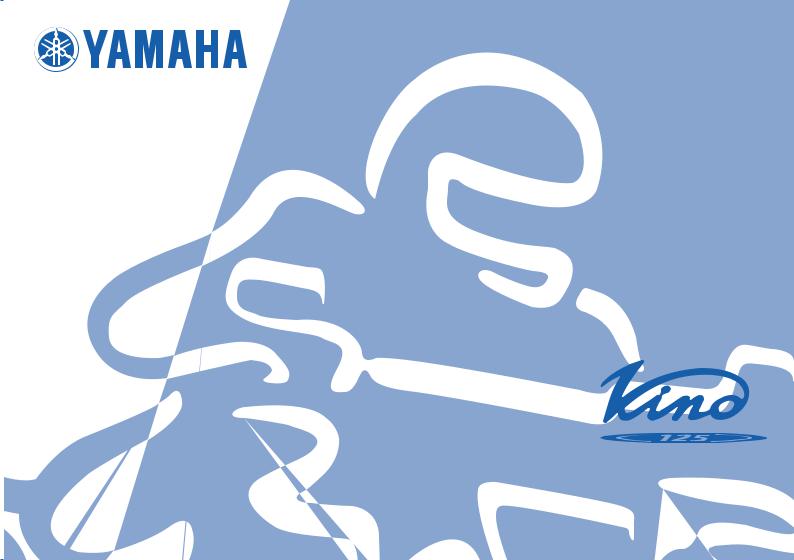
OWNER’S MANUAL
YJ125S
LIT-11626-17-43 |
5YR-F8199-10 |

EAU10041

EAU10050
INTRODUCTION
EAU10090
Congratulations on your purchase of the Yamaha VINO125. This model is the result of Yamaha’s vast experience in the production of fine sporting, touring, and pacesetting racing machines. It represents the high degree of craftsmanship and reliability that have made Yamaha a leader in these fields.
This manual will give you an understanding of the operation, inspection, and basic maintenance of this scooter. If you have any questions concerning the operation or maintenance of your scooter, please consult a Yamaha dealer.
The design and manufacture of thisYamaha scooter fully comply with the emissions standards for clean air applicable at the date of manufacture. Yamaha has met these standards without reducing the performance or economy of operation of the scooter. To maintain these high standards, it is important that you and your Yamaha dealer pay close attention to the recommended maintenance schedules and operating instructions contained within this manual.
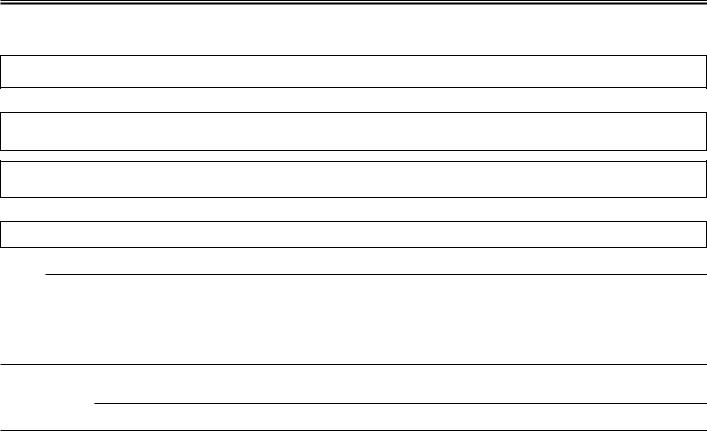
EAU10120
IMPORTANT MANUAL INFORMATION
EAU34110
Particularly important information is distinguished in this manual by the following notations:
Q
The Safety Alert Symbol means ATTENTION! BECOME ALERT!YOUR SAFETY IS INVOLVED!
wFailure to follow WARNING instructions could result in severe injury or death to the scooter operator, a bystander, or a person inspecting or repairing the scooter.
cC A CAUTION indicates special precautions that must be taken to avoid damage to the scooter.
NOTE: A NOTE provides key information to make procedures easier or clearer.
NOTE:
8This manual should be considered a permanent part of this scooter and should remain with it even if the scooter is subsequently sold.
8Yamaha continually seeks advancements in product design and quality.Therefore, while this manual contains the most current product information available at the time of printing, there may be minor discrepancies between your scooter and this manual. If you have any questions concerning this manual, please consult your Yamaha dealer.
EWA12410
w
PLEASE READTHIS MANUAL CAREFULLY AND COMPLETELY BEFORE OPERATINGTHIS SCOOTER.

IMPORTANT MANUAL INFORMATION
EAU10192
AFFIX DEALER
LABEL HERE
VINO125
OWNER’S MANUAL
©2003 byYamaha Motor Taiwan Co., Ltd. 1st edition, November 2003
All rights reserved.
Any reprinting or unauthorized use without the written permission of Yamaha Motor Taiwan Co., Ltd.
is expressly prohibited. Printed in Taiwan. P/N LIT-11626-17-43
TABLE OF CONTENTS |
|
|
|
EAU10210 |
|
|
|
|
|
||
|
|
|
|
||
SAFETY INFORMATION ....... |
1-1 |
Ignition circuit cut-off system 3-9 |
Replacing the tail/brake light |
||
Further safe-riding points ..... |
1-5 |
PRE-OPERATION CHECKS . 4-1 |
bulb .................................. |
6-11 |
|
Location of important labels .. |
1-6 |
Pre-operation check list........ |
4-2 |
Replacing a turn signal light |
|
DESCRIPTION ....................... |
2-1 |
OPERATION AND IMPORTANT |
bulb .................................. |
6-11 |
|
Left view ............................... |
2-1 |
RIDING POINTS .................... |
5-1 |
Checking the front brake pads |
|
Right view ............................. |
2-2 |
Starting a cold engine ........... |
5-1 |
and rear brake shoes ...... |
6-12 |
Controls and instruments ..... |
2-3 |
Starting off ............................ |
5-2 |
Checking the brake fluid |
|
INSTRUMENT AND CONTROL |
Acceleration and |
|
level ................................. |
6-13 |
|
FUNCTIONS........................... |
3-1 |
deceleration ....................... |
5-2 |
Changing the brake fluid ..... |
6-13 |
Main switch/steering lock ..... |
3-1 |
Braking ................................. |
5-3 |
Checking and lubricating the |
|
Indicator lights ...................... |
3-2 |
Engine break-in .................... |
5-3 |
cables .............................. |
6-14 |
Handlebar switches .............. |
3-2 |
Parking ................................. |
5-4 |
Checking and lubricating the |
|
Speedometer unit ................. |
3-3 |
PERIODIC MAINTENANCE |
|
throttle grip and cable ...... |
6-14 |
Fuel gauge ............................ |
3-3 |
AND MINOR REPAIR ............ |
6-1 |
Lubricating the front and rear |
|
Front brake lever .................. |
3-3 |
PERIODIC MAINTENANCE 6-1 |
brake levers ..................... |
6-14 |
|
Rear brake lever ................... |
3-4 |
Owner’s tool kit ..................... |
6-1 |
Checking and lubricating the |
|
Fuel tank cap ........................ |
3-4 |
Periodic maintenance chart for |
centerstand and |
|
|
Fuel ...................................... |
3-5 |
the emission control |
|
sidestand ......................... |
6-15 |
Catalytic converter ............... |
3-5 |
system ............................... |
6-2 |
Checking the front fork ....... |
6-15 |
Kickstarter ............................ |
3-6 |
General maintenance and |
|
Checking the steering ........ |
6-16 |
Seat ...................................... |
3-6 |
lubrication chart ................. |
6-3 |
Replacing the headlight |
|
Helmet holder ....................... |
3-6 |
Removing and installing |
|
bulb .................................. |
6-16 |
Storage compartment ........... |
3-7 |
panels ................................ |
6-6 |
Final transmission oil .......... |
6-17 |
Luggage hook ....................... |
3-8 |
Checking the spark plug....... |
6-7 |
Adjusting the carburetor ..... |
6-19 |
Carrier .................................. |
3-8 |
Air filter and V-belt case air filter |
Adjusting the throttle cable free |
||
Sidestand ............................. |
3-8 |
elements ............................ |
6-8 |
play .................................. |
6-19 |

TABLE OF CONTENTS
Tires ................................... |
6-19 |
Cast wheels ....................... |
6-21 |
Adjusting the brake lever free |
|
play .................................. |
6-21 |
Adjusting the rear brake lever |
|
free play ........................... |
6-21 |
Battery ................................ |
6-22 |
Replacing the fuse .............. |
6-23 |
Engine oil and oil strainer.... |
6-24 |
Troubleshooting .................. |
6-26 |
Troubleshooting chart ......... |
6-27 |
SCOOTER CARE AND STOR- |
|
AGE ........................................ |
7-1 |
Care...................................... |
7-1 |
Storage ................................. |
7-3 |
SPECIFICATIONS ................. |
8-1 |
CONSUMER INFORMATION 9-1 |
|
Identification numbers .......... |
9-1 |
Reporting safety defects ...... |
9-3 |
Motorcycle noise regulation .. |
9-4 |
YAMAHA MOTOR CORPORA-
TION, U.S.A STREET AND
ENDURO MOTORCYCLE |
|
LIMITED WARRANTY ....... |
9-5 |
YAMAHA EXTENDED SER- |
|
VICE (Y.E.S.) ..................... |
9-7 |

EAU10220
Q SAFETY INFORMATION
EAU10260
SCOOTERS ARE SINGLE TRACK VEHICLES. THEIR SAFE USE AND OPERATION ARE DEPENDENT UPON
1THE USE OF PROPER RIDING TECHNIQUES AS WELL AS THE EXPERTISE OF THE OPERATOR. EVERY OPERATOR SHOULD KNOW THE FOLLOWING REQUIREMENTS BEFORE RIDING THIS SCOOTER.
HE OR SHE SHOULD:
8 OBTAIN THOROUGH INSTRUCTIONS FROM A COMPETENT SOURCE ON ALL ASPECTS OF SCOOTER OPERATION.
8 OBSERVE THE WARNINGS AND MAINTENANCE REQUIREMENTS IN THE OWNER’S MANUAL.
8 OBTAIN QUALIFIED TRAINING IN SAFE AND PROPER RIDING TECHNIQUES.
8 OBTAIN PROFESSIONAL TECHNICAL SERVICE AS INDICATED BY THE OWNER’S MANUAL AND/ OR WHEN MADE NECESSARY BY MECHANICAL CONDITIONS.
Safe riding
8Always make pre-operation checks. Careful checks may help prevent an accident.
8This scooter is designed to carry the operator and passenger.
8The failure of motorists to detect and recognize scooters in traffic is the predominating cause of automobile/scooter accidents. Many accidents have been caused by an automobile driver who did not see the scooter. Making yourself conspicuous appears to be very effective in reducing the chance of this type of accident.
Therefore:
9 Wear a brightly colored jacket.
9Use extra caution when approaching and passing through intersections, since intersections are the most likely places for scooter accidents to occur.
9Ride where other motorists can see you. Avoid riding in another motorist’s blind spot.
8 Many accidents involve inexperienced operators. In fact, many operators who have been involved in accidents do not even have a current driver’s license.
9Make sure that you are qualified and that you only lend your scooter to other qualified operators.
9Know your skills and limits. Staying within your limits may help you to avoid an accident.
9We recommend that you practice riding your scooter where there is no traffic until you have become thoroughly
familiar with the scooter and all of its controls.
Many accidents have been caused by error of the scooter operator. A typical error made by the operator is veering wide on a turn due to EXCESSIVE SPEED or undercornering (insufficient lean angle for the speed).
9Always obey the speed limit and never travel faster than warranted by road and traffic conditions.
1-1

Q SAFETY INFORMATION
9Always signal before turning or changing lanes. Make sure that other motorists can see you.
8 The posture of the operator and passenger is important for proper control.
9The operator should keep both hands on the handlebar and both feet on the footboard during operation to maintain control of the scooter.
9The passenger should always hold onto the operator, the seat strap or grab bar, if equipped, with both hands and keep both feet on the passenger foot-
rests.
9Never carry a passenger unless he or she can firmly place both feet on the passenger footrests.
8Never ride under the influence of alcohol or other drugs.
This scooter is designed for on-road use only. It is not suitable for offroad use.
Protective apparel
The majority of fatalities from scooter accidents are the result of head injuries. The use of a safety helmet is the single most critical factor in the prevention or reduction of head injuries.
8 Always wear an approved helmet.
8Wear a face shield or goggles.Wind in your unprotected eyes could contribute to an impairment of vision which could delay seeing a hazard.
8 The use of a jacket, substantial shoes, trousers, gloves, etc., is effective in preventing or reducing abrasions or lacerations.
8 Never wear loose-fitting clothes, otherwise they could catch on the control levers or wheels and cause injury or an accident.
8Never touch the engine or exhaust system during or after operation. They become very hot and can cause burns. Always wear protective clothing that covers your legs, ankles, and feet.
8 Passengers should also observe the above precautions.
Modifications
Modifications made to this scooter not approved byYamaha, or the removal of original equipment, may render the 1 scooter unsafe for use and may cause severe personal injury. Modifications may also make your scooter illegal to use.
Loading and accessories
Adding accessories or cargo to your scooter can adversely affect stability and handling if the weight distribution of the scooter is changed. To avoid the possibility of an accident, use extreme caution when adding cargo or accessories to your scooter.Use extra care when riding a scooter that has added cargo or accessories. Here are some general guidelines to follow if loading cargo or adding accessories to your scooter:
1-2

Q SAFETY INFORMATION
|
Loading |
Accessories |
|
|
The total weight of the operator, passen- |
Genuine Yamaha accessories have |
|
|
ger, accessories and cargo must not ex- |
been specifically designed for use on |
|
1 |
ceed the maximum load limit of 144 kg |
this scooter. Since Yamaha cannot test |
|
(317 lb).When loading within this weight |
all other accessories that may be avail- |
||
|
|||
|
limit, keep the following in mind: |
able, you must personally be responsible |
|
|
8 Cargo and accessory weight should |
for the proper selection, installation and |
|
|
be kept as low and close to the |
use of non-Yamaha accessories. Use |
|
|
scooter as possible. Make sure to |
extreme caution when selecting and in- |
|
|
distribute the weight as evenly as |
stalling any accessories. |
|
|
possible on both sides of the |
Keep the following guidelines in mind, |
|
|
scooter to minimize imbalance or |
as well as those provided under “Load- |
|
|
instability. |
ing” when mounting accessories. |
|
|
8 Shifting weights can create a sud- |
8 Never install accessories or carry |
|
|
den imbalance. Make sure that ac- |
cargo that would impair the perfor- |
|
|
cessories and cargo are securely |
mance of your scooter. Carefully |
|
|
attached to the scooter before riding. |
inspect the accessory before us- |
|
|
Check accessory mounts and |
ing it to make sure that it does not |
|
|
cargo restraints frequently. |
in any way reduce ground clear- |
|
|
8 Never attach any large or heavy |
ance or cornering clearance, limit |
|
|
items to the handlebar, front fork, |
suspension travel, steering travel |
|
|
or front fender. Such items can cre- |
or control operation, or obscure |
|
|
ate unstable handling or a slow |
lights or reflectors. |
|
|
steering response. |
9 Accessories fitted to the |
|
|
|
handlebar or the front fork area |
|
|
|
can create instability due to |
|
|
|
improper weight distribution or |
|
|
|
aerodynamic changes. If |
accessories are added to the handlebar or front fork area, they must be as lightweight as possible and should be kept to a minimum.
9Bulky or large accessories may seriously affect the stability of the scooter due to aerodynamic effects. Wind may attempt to lift the scooter, or the scooter may become unstable in cross winds. These accessories may also cause instability when passing or being passed by large vehicles.
9 Certain accessories can displace the operator from his or her normal riding position. This improper position limits the freedom of movement of the operator and may limit control ability, therefore, such accessories are not recommended.
8Use caution when adding electrical accessories. If electrical accessories exceed the capacity of the scooter’s electrical system an elec-
1-3

Q SAFETY INFORMATION
tric failure could result, which could cause a dangerous loss of lights or engine power.
Gasoline and exhaust gas
8 GASOLINE IS HIGHLY FLAMMABLE:
9Always turn the engine off when refueling.
9Take care not to spill any gasoline on the engine or exhaust system when refueling.
9Never refuel while smoking or in the vicinity of an open flame.
8Never start the engine or let it run for any length of time in a closed
area. The exhaust fumes are poisonous and may cause loss of consciousness and death within a short time. Always operate your scooter in an area that has adequate ventilation.
8Always turn the engine off before leaving the scooter unattended and remove the key from the main switch. When parking the scooter, note the following:
9 The engine and exhaust |
|
|
system may be hot, therefore, |
|
|
park the scooter in a place |
|
|
where pedestrians or children |
1 |
|
are not likely to touch these hot |
||
|
||
areas. |
|
|
9 Do not park the scooter on a |
|
|
slope or soft ground, otherwise |
|
|
it may fall over. |
|
|
9 Do not park the scooter near a |
|
|
flammable source (e.g., a |
|
|
kerosene heater, or near an |
|
|
open flame), otherwise it could |
|
|
catch fire. |
|
8If you should swallow any gasoline, inhale a lot of gasoline vapor, or allow gasoline to get into your eyes, see your doctor immediately. If any gasoline spills on your skin or clothing, immediately wash the affected area with soap and water and change your clothes.
1-4

Q SAFETY INFORMATION
EAU10350
Further safe-riding points
1
ZAUM00**
Turn left
ZAUM00**
Turn right
8Make sure to signal clearly when making turns.
8Braking can be extremely difficult on a wet road. Avoid hard braking, because the scooter could slide. Apply the brakes slowly when stopping on a wet surface.
8Slow down as you approach a corner or turn. Once you have completed a turn, accelerate slowly.
8 Be careful when passing parked cars. A driver might not see you and open a door in your path.
8Railroad crossings, streetcar rails, iron plates on road construction sites, and manhole covers become extremely slippery when wet. Slow down and cross them with caution.
Keep the scooter upright, otherwise it could slide out from under you.
8The brake lining could get wet when you wash the scooter. After washing the scooter, check the brakes before riding.
8Always wear a helmet, gloves, trousers (tapered around the cuff and ankle so they do not flap), and a bright colored jacket.
8Do not carry too much luggage on the scooter. An overloaded scooter
is unstable. Use a strong cord to secure any luggage to the carriers. A loose load will affect the stability of the scooter and could divert your attention from the road. (See page 1-2.)
1-5
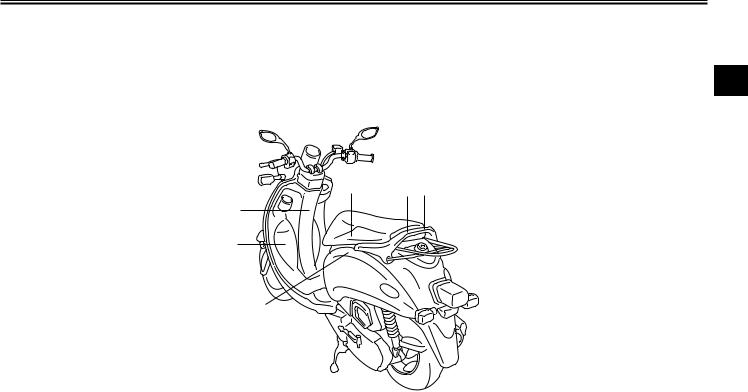
Q SAFETY INFORMATION
EAU10381
Location of important labels
Please read the following important labels carefully before operating this vehicle.
1
1 |
2 |
3 |
|
6
5
4
1-6
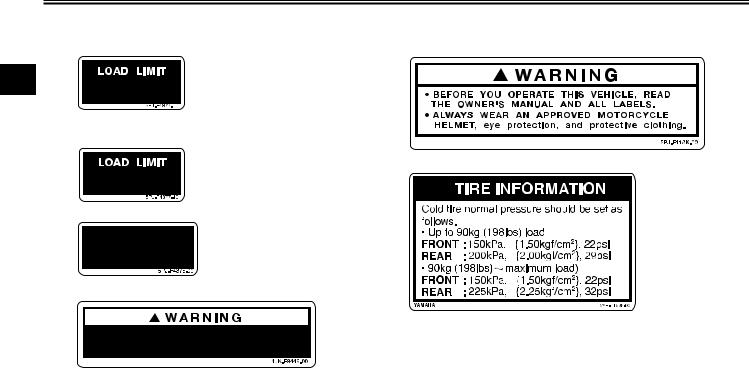
Q SAFETY INFORMATION
1 |
5 |
1
2
6
3
4
1-7
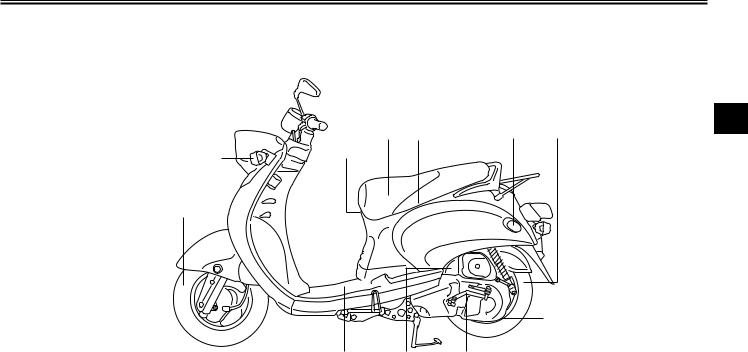
DESCRIPTION
Left view
2
1
1.Front wheel (page 6-19)
2.Front turn signal light (page 3-2)
3.Luggage hook (page 3-8)
4.Helmet holder (page 3-6)
5.Storage compartment (page 3-7)
6.Rear turn signal light (page 3-2)
7.Rear wheel (page 6-19)
8.Rear brake lever free play adjusting nut (page 6-21)
9.Kickstarter (page 3-6)
10.Air filter element (page 6-8) 11.Battery (page 6-22)
EAU10410
2
4 |
5 |
6 |
7 |
3
|
|
8 |
11 |
10 |
9 |
2-1
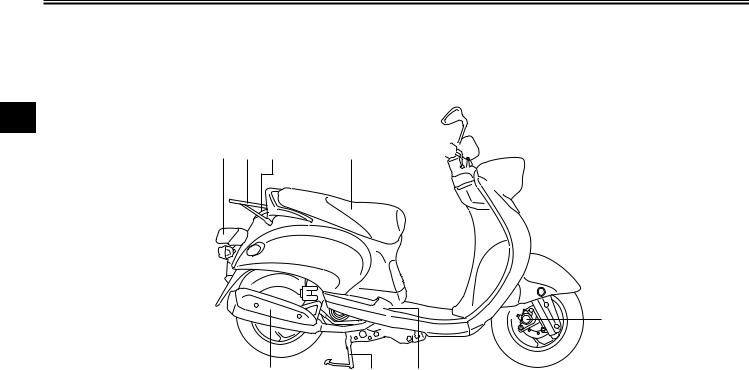
DESCRIPTION
EAU10420
Right view
2
12 13 14 15 16 


 17
17
18
12.Tail/brake light (page6-11) |
21 |
20 |
19 |
13.Carrier (page3-8)
14.Fuel tank cap (page 3-4) 15.Seat (page 3-6)
16.Brake master cylinder (page 6-13) 17.Headlight (page 6-16)
18.Front brake caliper (page 6-12)
19.Spark plug (page 6-7) 20.Centerstand (page 6-15)
21.Muffler (page 3-5)
2-2
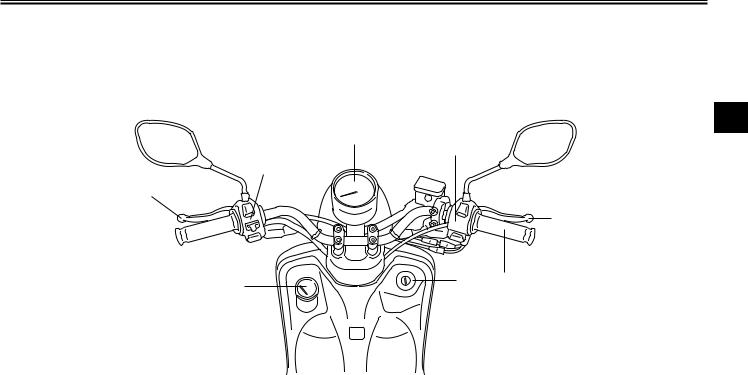
DESCRIPTION
EAU10430
Controls and instruments
2
24
25
23
22
26
29 |
28 |
27 |
|
|
22.Rear brake lever (page 3-4) 23.Left handlebar switches (page 3-2)
24.Speedometer unit (page 3-3)
25.Right handlebar switches (page 3-2) 26.Front brake lever (page 3-3) 27.Throttle grip (page 6-19)
28.Main switch / steering lock (page 3-1) 29.Fuel gauge (page 3-3)
2-3
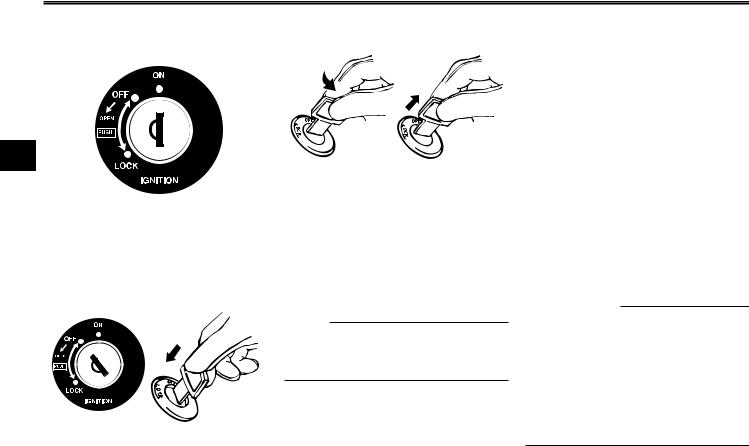
INSTRUMENT AND CONTROL FUNCTIONS
EAU10460
Main switch/steering lock
3
ZAUM00**
The main switch/steering lock controls the ignition and lighting systems, and is used to lock the steering. The various positions are described below.
1
ZAUM00**
1. Push
1
2
ZAUM00**
1.Turn
2.Release
EAU10530
ON
All electrical circuits are supplied with power, the taillight comes on, and the engine can be started. The key cannot be removed.
NOTE:
The headlight and meter lighting come on automatically when the engine is started.
EAU10660
OFF
All electrical systems are off. The key can be removed.
EAU10680
LOCK
The steering is locked, and all electrical systems are off. The key can be removed.
To lock the steering
1.Turn the handlebars all the way to the left.
2.Push the key in from the “OFF” position, and then turn it to “LOCK” while still pushing it.
3.Remove the key.
To unlock the steering
Push the key in, and then turn it to “OFF” while still pushing it.
EWA10060
w
Never turn the key to “OFF” or “LOCK” while the vehicle is moving, otherwise the electrical systems will be switched off, which may result in loss of control or an accident. Make sure that the vehicle is stopped before turning the key to “OFF” or “LOCK”.
3-1
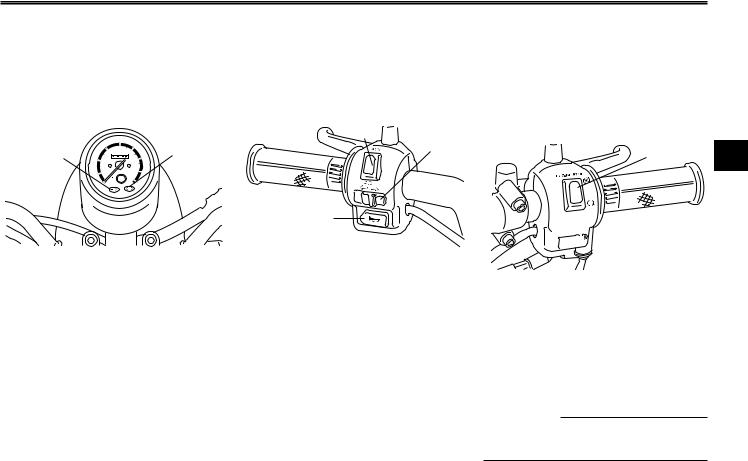
INSTRUMENT AND CONTROL FUNCTIONS
EAU10980
Indicator lights
EAU11020
Turn signal indicator light “5”
This indicator light flashes when the turn signal switch is pushed to the left or right.
EAU12342
Handlebar switches
EAU12400
Dimmer switch “%/&”
Set this switch to “&” for the high beam and to “%” for the low beam.
EAU12660
Engine stop switch “#/$”
Set this switch to “#” before starting the engine. Set this switch to “$” to stop the engine in case of an emergency, such as when the motorcycle overturns or when the throttle cable is stuck.
|
|
|
40 |
|
2 |
1 |
|
30 |
50 |
||
|
|
60 |
|
||
|
|
80 |
|
||
20 |
40 |
100 |
60 |
||
|
|
20 |
|
70 |
|
|
10 |
|
120 |
|
|
|
|
0 |
|
|
|
|
|
|
|
|
|
|
|
0 |
|
80 |
|
|
|
MPH |
|
|
|
ZAUM00**
1.High beam indicator light ”&”
2.Turn indicator light “5”
EAU11080
High beam indicator light “&”
This indicator light comes on when the high beam of the headlight is switched on.
1
2
3
ZAUM00**
1.Dimmer switch “%/&“
2.Turn signal switch “4/6”
3.Horn switch “*”
EAU12460
Turn signal switch “4/6”
To signal a right-hand turn, push this switch to “4”.To signal a left-hand turn, push this switch to “6”.When released, the switch returns to the center position. To cancel the turn signal lights, push the switch in after it has returned to the center position.
EAU12500
Horn switch “*”
Press this switch to sound the horn.
1 3
 2
2
ZAUM00**
1.Engine stop switch “#/$“
2.Start switch “,”
EAU12700
Start switch“,”
Push this switch while applying the front or rear brake to crank the engine with the starter.
ECA10050
cC
See page 5-1 for starting instructions prior to starting the engine.
3-2
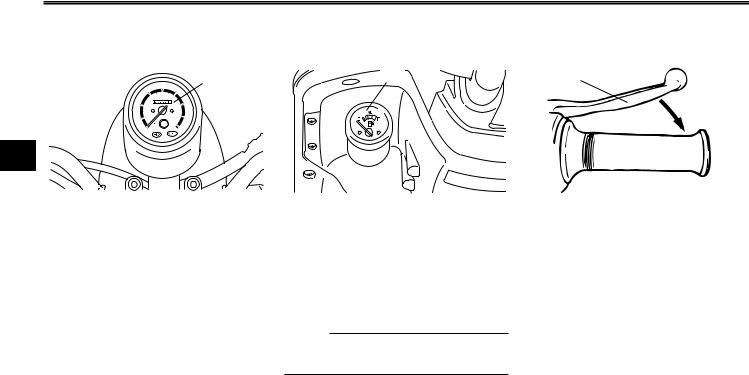
INSTRUMENT AND CONTROL FUNCTIONS
|
EAU11620 |
EAU12150 |
EAU12900 |
Speedometer unit |
Fuel gauge |
|
Front brake lever |
|
40 |
|
30 |
50 |
|
|
60 |
|
|
80 |
60 |
40 |
|
|
20 |
100 |
|
20 |
|
70 |
10 |
120 |
|
0 |
|
|
|
|
|
0 |
|
80 |
MPH |
|
|
1 |
1 |
1 |
3
ZAUM00** |
ZAUM00** |
ZAUM00** |
1. Speedometer
The speedometer unit is equipped with a speedometer and an odometer. The speedometer shows riding speed. The odometer shows the total distance traveled.
1. Fuel gauge
The fuel gauge indicates the amount of fuel in the fuel tank. The needle moves towards “E” (Empty) as the fuel level decreases.When the needle reaches the red line, refuel as soon as possible.
NOTE:
Do not allow the fuel tank to empty itself completely.
1. Front brake lever
The front brake lever is located on the right handlebar grip. To apply the front brake, pull this lever toward the handlebar grip.
3-3

INSTRUMENT AND CONTROL FUNCTIONS
EAU12950
Rear brake lever
1
ZAUM00**
1. Rear brake lever
The rear brake lever is located on the left handlebar grip. To apply the rear brake, pull this lever toward the handlebar grip.
EAU32430
Recommended fuel:
REGULAR UNLEADED GASOLINE ONLY
Fuel tank capacity:
4.5 L (1.18 US gal) (0.98 Imp.gal)
YourYamaha engine has been designed to use regular unleaded gasoline with a pump octane number [(R+M)/2] of 86 or higher, or a research octane number of 91 or higher. If knocking (or pinging) occurs, use a gasoline of a different brand or a gasoline or premium unleaded fuel. Use of unleaded fuel will extend spark plug life and reduce maintenance cost.
Gasohol
There are two types of gasohol: gasohol containing ethanol and that containing methanol. Gasohol containing ethanol can be used if ethanol content does not exceed 10%. Gasohol containing methanol is not recommended by Yamaha because it can cause damage to the fuel system or vehicle performance problems.
EAU32481
Fuel tank cap
2
1
3
ZAUM00**
1.Fuel tank cap cover
2.Match mark
To remove the fuel tank cap
Slide the lock cover open, insert the key into the lock, and then turn it 1/4 turn clockwise.The lock will be released and the fuel tank cap can be removed.
To install the fuel tank cap
1.Insert the fuel tank cap into the tank opening with the key inserted in the lock and with the marks on the cap and tank aligned.
2.Turn the key counterclockwise to the original position, remove it, and then close the lock cover.
3-4
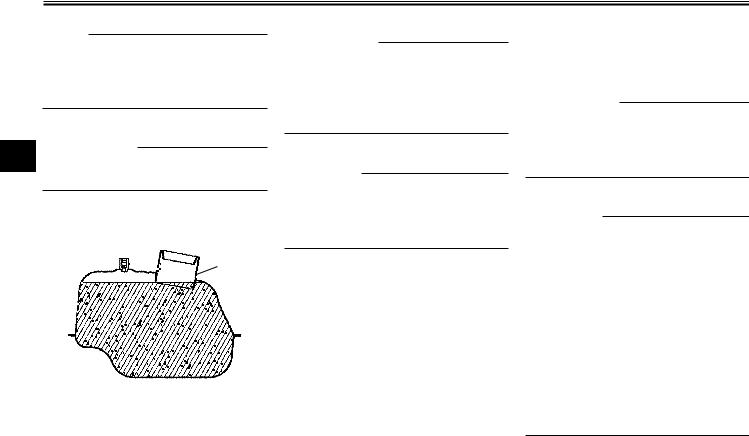
INSTRUMENT AND CONTROL FUNCTIONS
NOTE:
The fuel tank cap cannot be installed unless the key is in the lock. In addition, the key cannot be removed if the cap is not properly installed and locked.
EWA10130
w
3Make sure that the fuel tank cap is properly installed before riding.
EAU13210
Fuel
1
ZAUM00**
1. Fuel tank filler tube
Make sure that there is sufficient fuel in the tank. Fill the fuel tank to the bottom of the filler tube as shown.
EWA10880
w
8Do not overfill the fuel tank, otherwise it may overflow when the fuel warms up and expands.
8 Avoid spilling fuel on the hot engine.
ECA10070
cC
Immediately wipe off spilled fuel with a clean, dry, soft cloth, since fuel may deteriorate painted surfaces or plastic parts.
EAU13440
Catalytic converter
This vehicle is equipped with a catalytic converter in the muffler.
EWA10860
w
The exhaust system is hot after operation. Make sure that the exhaust system has cooled down before doing any maintenance work.
ECA10700
cC
The following precautions must be observed to prevent a fire hazard or other damages.
8Use only unleaded gasoline.The use of leaded gasoline will cause unrepairable damage to the catalytic converter.
8Never park the vehicle near possible fire hazards such as grass or other materials that easily burn.
8Do not allow the engine to idle too long.
3-5
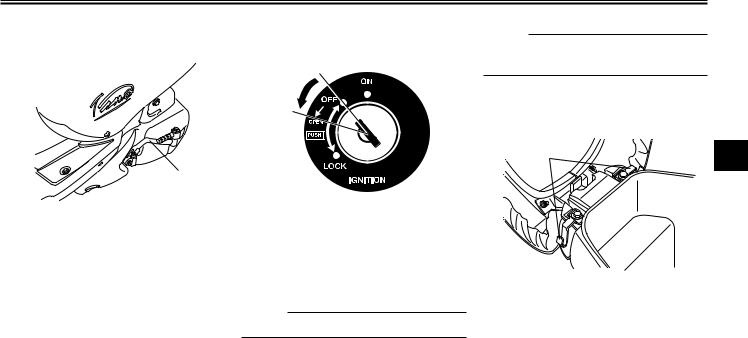
INSTRUMENT AND CONTROL FUNCTIONS
EAU13680 |
EAU13931 |
Kickstarter |
Seat |
|
OPEN |
1 |
|
ZAUM00** |
ZAUM00** |
1. Kickstarter
To start the engine, fold out the kickstarter lever, move it down lightly with your foot until the gears engage, and then push it down smoothly but forcefully.
To open the seat
1.Place the scooter on the centerstand.
2.Insert the key into the main switch, and then turn it counterclockwise.
NOTE:
Do not push inward when turning the key.
3. Fold the seat up.
To close the seat
1.Fold the seat down, and then push it down to lock it in place.
2.Remove the key from the main switch if the scooter will be left unattended.
NOTE:
Make sure that the seat is properly secured before riding.
EAU14300
Helmet holder
1 |
3 |
ZAUM00**
1. Helmet holder (x2)
The helmet holder is located under the seat.
To secure a helmet to the helmet holder
1.Open the seat. (See page 3-6.)
2.Attach the helmet to the helmet holder, and then securely close the seat.
3-6
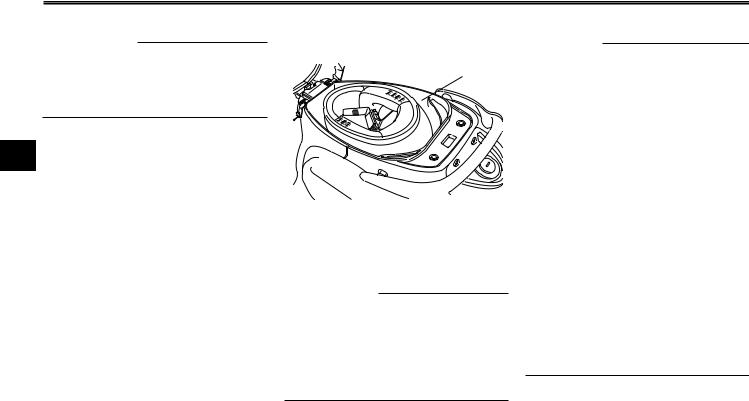
INSTRUMENT AND CONTROL FUNCTIONS
EWA10160
w
Never ride with a helmet attached to the helmet holder, since the helmet may hit objects, causing loss of control and possibly an accident.
To release the helmet from the hel-
3met holder
Open the seat, remove the helmet from the helmet holder, and then close the seat.
EAU14510
Storage compartment
1
ZAUM00**
1. Storage compartment
There is a storage compartment under the seat. (See page 3-6.)
EWA10960
w
8Do not exceed the load limit of 5 kg (11 lb) for the storage compartment.
8 Do not exceed the maximum load of 144 kg (317 lb) for the vehicle.
ECA10080
cC
Keep the following points in mind when using the storage compartment.
8Since the storage compartment accumulates heat when exposed to the sun, do not store anything susceptible to heat inside it.
8To avoid humidity from spreading through the storage compartment, wrap wet articles in a plastic bag before storing them in the compartment.
8Since the storage compartment may get wet while the scooter is
being washed, wrap any articles stored in the compartment in a plastic bag.
8Do not keep anything valuable or breakable in the storage compartment.
To store a helmet in the storage compartment, place the helmet upside-down with the front facing forward.
3-7
